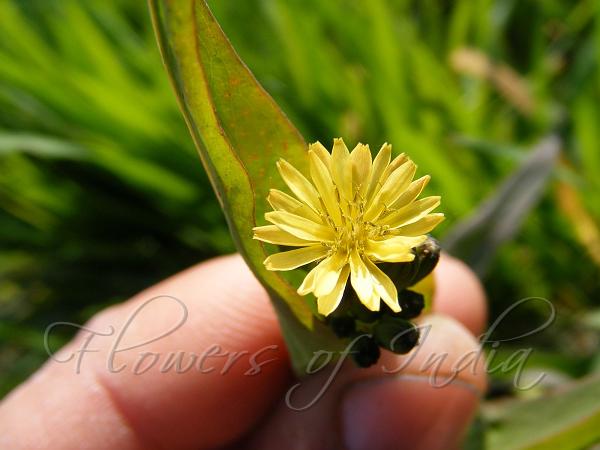|
| Many-Flowered Ixeris |
|

|

| File size | 373906 |
| Original date | 1/30/12 12:19 PM |
| Resolution | 2000 x 1500 |
| Flash | Flash did not fire, auto |
| Focal length | 6.3mm |
| Exposure time | 1/320s |
| Aperture | 5.0 |
| Focus Distance | 0.0m |
| Metering Mode | Multi-segment |
| Camera make | FUJIFILM |
| Camera model | FinePix S5700 S700 |
| Sensor type | OneChipColorArea |
|
|
|
|
Photo: |
Botanical name: Ixeris polycephala Family: Asteraceae (Sunflower family)
Synonyms: Lactuca polycephala, Chondrilla longifolia, Lactuca matsumura
Synonyms: Lactuca polycephala, Chondrilla longifolia, Lactuca matsumura
Many-Flowered Ixeris is an annual herb 10-50 cm tall,
with stem solitary, erect, branched already in lower half or higher up,
hairless, leafy. Flower-heads are borne in corymbs, with few to some
flower-heads. Flower-heads have 20-25 florets; flower-cluster-stalk
capillaceous. Florets are yellow or rarely white. Anther tube and style
greenish to blackish upon drying. Involucre is cylindric and 5-6 × 2-3
mm at anthesis, broadly bell-shaped and 7-8 x 4-5 mm in fruit.
Phyllaries below hairless; outer phyllaries 4-6, ovate, longest less
than 1 mm, tip pointed; inner phyllaries 8, tip pointed to blunt. Basal
leaves are narrowly inverted-lanceshaped to linear, 6-22 x 0.3-1.5 cm,
undivided or pinnately cut, base narrowed into a well-developed
leaf-stalk-like portion and semi-stem-clasping, margin entire or
toothed, tip pointed; lateral lobes (if present) 2-5 pairs, on leaf
blade basal 1/2-2/3. Stem leaves are lanceshaped to linear-lanceshaped,
smaller, rather undivided, base strongly arrow-shaped, stem clasping,
margin mostly entire, otherwise similar to basal leaves. Seedpods are
brown to reddish brown, ellipsoid, about 4 mm, tip contracted into a
slender 1-1.5 mm beak. Many-Flowered Ixeris is found in the Himalayas,
from Afghanistan, Kashmir to Nepal, NE India, Bhutan, Cambodia, Laos,
Myanmar, Vietnam and Japan, at altitudes of 100-2000 m. Flowering:
November-March.
| Identification credit: Nidhan Singh | Photographed in Kaithal, Haryana. |
• Is this flower misidentified? If yes,